FROM FUTURISTIC CONCEPTS TO A REAL SOLUTION FOR TOMORROW
- THE EVOLUTION OF PIVO -
With the reveal of PIVO 3 at the 2011 Tokyo Motor Show, Nissan's PIVO EV concept is now in its third generation. The original PIVO, introduced at the 2005 Tokyo Motor Show, revolutionized the perception of electric vehicles. PIVO 2 followed at the 2007 Tokyo Motor Show, breaking new ground in zero emission mobility. And now, with PIVO 3, Nissan showcases a mobility solution that may change our lives - tomorrow.
All PIVO projects are part of Nissan's extensive, multi-year exploration of zero emission mobility that has led to more than eight concepts revealed globally. In December 2010, Nissan LEAF addressed the core mobility market with zero emission technology. But the vision has always been about resetting the rules of the game, not just making new products. Through concept cars and future production cars, Nissan continues to ask how zero emission mobility will expand around the world and what zero emission will bring to the mobility ecosystem. The company believes the world is changing and zero emission vehicles have a role to play to make it better.
EV as a new paradigm
Nissan Product Chief Designer Masato Inoue, who designed all three PIVOs and Nissan LEAF, says, "I want to design not only the EV, but the life around the EV and the wonderful benefits that EVs bring." From the very beginning, the PIVO development team understood that electric propulsion is more than an alternative to conventional powertrains. It is a new paradigm - a game changer for automakers and a life changer for consumers. It forces the automaker to become a comprehensive mobility solutions provider rather than just a manufacturer of cars. It offers the EV user a new way of life, potentially rearranging not only the human-vehicle relationship, but also the way drivers - and their cars - interact with other people and the cities in which they live and drive.
PIVO as an illustration of the future
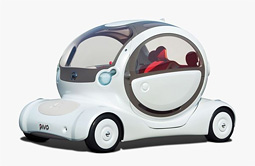
Early in the decade, a self-selected group of Nissan employees from R&D, design and product planning backgrounds came together to explore the future of electric vehicles in a concept car that would become the first generation PIVO. Key members of this "Denki Group" (denki means electric in Japanese) were Inoue, Masahiko Tabe of Nissan's Advanced Vehicle Engineering Department, Tatsuya Shiosaki of Nissan's Exploratory and Advanced Product Department, and Hidetoshi Kadota, who would later become Chief Vehicle Engineer for Nissan LEAF. Inoue, Tabe and Shiosaki also joined hands to develop PIVO 2 and PIVO 3. Furthermore, Creative Box Inc. Nissan's advanced design studio located in Harajuku, Tokyo, has been involved in the design development stage of all PIVOs. Having most of the original team stay on through three generations of concept car development spanning more than five years is rare in the industry, and it reflects a unique tenacity brought forward through their sense of purpose.
During the first-generation PIVO's infancy, the Denki Group was on its own, with its members participating in a voluntary capacity. But by being somewhat independent, it could entertain and pursue any idea, and consider every approach to overcoming the challenges on the way to the goal.
Since electric propulsion and drive-by-wire control technology eliminate many aspects of motor vehicles that is taken for granted, freedom of packaging and design was a given. At the time, auto-makers around the world recognized the freedom provided by this new technology as an opportunity to create outlandish concept cars that would capture media attention. But the members of Nissan's group wanted to do more. They wanted to solve real-world problems and communicate the potential of EVs to change lifestyles.
Thinking outside the "eco-friendly" box
Nissan already had more than half a century of technical expertise in EVs, going back to the 1947 debut of the Tama Electric Car. But the time had come to teach the EV new tricks. The time had come for PIVO.
Typical consumer attitudes toward electric cars in the past were limited to the image of an EV as merely a utilitarian vehicle for short-distance commuting and local shopping. Eye-catching concept cars did little to enhance the EV's real-world appeal. What was needed was an EV concept that would clearly demonstrate benefits beyond frugality and the environment. PIVO's mission has always been to illustrate how daily life changes with EVs.
The road from PIVO to PIVO 3
Each generation of PIVO has highlighted future lifestyle benefits from a slightly different angle.
The first generation PIVO showed how an EV can make city life easier, taking advantage of the layout freedom offered by an electric vehicle. .For example, in the planning stage, many ideas were suggested using by-wire technology. In the end, the group decided to take up the challenge of creating a rotating cabin. With its fully rotating cabin, this PIVO eliminated the need to reverse. The first-generation PIVO became a star attraction of the 2005 Tokyo Motor Show, creating recognition for its development team and opening up access to company resources, including additional staff, that would sustain progress going forward to the next generation.
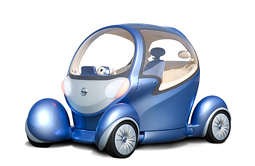
PIVO 2 pushed the envelope of by-wire technologies, demonstrating the benefits of in-wheel motors, which eliminate the need for axles and steering rack. This enables the four wheels to move independently. Thus, the car can even move sideways, in addition to cabin rotation. It makes parking much easier and can even change the center of gravity when cornering. Its front-opening door also permitted access in tight parking spaces. When turning, the wheels are rotated in the direction of the turn, keeping weight evenly distributed among all four wheels.
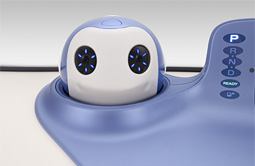
At that time, PIVO 2 took the first step from "car as tool" to "car as connection". A Robotic Agent serves as part of the human-machine interface (HMI), acting as a personal assistant and companion to the driver. Going much further than a standard GPS navigation system, it observes and interacts with the driver, delivering relevant information and commentary based on the driver's behavior and known preferences, as well as vehicle location and situation. Applying artificial intelligence technology, it also engages the driver's emotions to encourage a positive attitude and foster a feeling of attachment, like the bond you might feel with a young child riding in the same car.
PIVO 3 makes its debut nearly one year after the launch of Nissan LEAF, irrefutable evidence of Nissan's leadership - along with Alliance partner Renault - in the zero emission market and of the company's intent to transform the future of personal mobility. With Nissan LEAF as the historical EV sales leader proving electric vehicle viability on roads around the world, developers of the third generation PIVO could go on to make new points about what electric vehicles could offer beyond economical operation and conventional concepts of environmental friendliness.
At the same time, Nissan LEAFs presence in the real world made PIVO's developers feel that their next car needed to come closer to real-world feasibility and operability than its predecessors. If Nissan LEAF is the EV of today, then PIVO 3 should represent the benefits that an EV heralds for the near future.
Connected to society and community
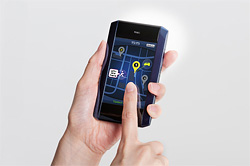
In terms of communication, PIVO 2 was about building a relationship between car and driver. The driver talks with the Robotic Agent to help navigate the city. With PIVO 3, the car talks to the city. "It connects to energy sources, houses and public facilities through the cloud - it actually sends out its own information. It finds out where open parking spaces are, goes there, and charges all by itself", says Shiosaki. "It becomes embedded in the social infrastructure. So it contributes to both society and to the user. The car can give electricity to the grid that it has generated while driving. This can take the place of a parking fee. We are not just delivering a car, but a total mobility solution where you won't have to worry about battery charging and you will enjoy conveniences such as Automated Valet Parking (AVP)."
With AVP, parking lots can hold many more cars because the car doors never have to open while the vehicle is parked. Such dedicated parking lots would be equipped with wireless chargers and populated with mini EVs that people could use as needed - like an urban bicycle-sharing system. This would provide mobility in a casual and convenient new format while balancing electric power supply on the grid. Mobility becomes a service - always-on, ubiquitous and reliable. This is the kind of future that Nissan is working to achieve - one in which infrastructure and systems interact with EVs to create a zero emission society.
Engineered for the real world - enabling U-turns in the narrowest of standard roads
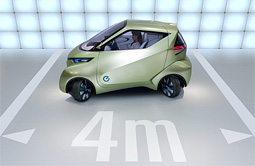
The first two PIVO generations allowed drivers to park in tiny spaces and switch directions without having to back out. However, a rotating cabin, despite its merits, would require major changes in vehicle platforms that would make it difficult to offer such a vehicle in the near future at an accessible price. It was therefore necessary to find a way to deliver the same level of convenience in a package that could be mass-produced cost effectively. "Most of the world's roads are at least four meters wide, so the challenge was to create a car that could make a U-turn within that width limitation," says Tabe. "This is basically possible if the body length is under two meters, but the body may scrape the curb when making such a sharp turn. The bottleneck was the rear wheels. Using three wheels would work but creates unacceptable restrictions on interior space and exterior styling. We used 3D simulation to find a solution." This persistence resulted in PIVO 3's distinctive 450 mm narrow-tread rear wheels.
Next stage of EV evolution
Throughout its three generations, the PIVO series has offered the world many exciting ideas in an appealing form that everyone can grasp. The first generation PIVO suggested a new shape for cars. PIVO 2 added a new relationship between cars and people. Both were concept cars that explored the possibilities of innovative technology. PIVO 3 evolves in the direction of the "smart community" with greater feasibility, credibility and an extended scope of mobile performance. Nissan aims to lead the way as a mobility solutions provider, bringing the world solutions that will accelerate the popularization of EVs that are convenient and easy to drive for anyone, anywhere.
PIVO 3 is one step on this journey. With PIVO 3, Nissan shows how EVs can change the way people will live in the cities of the near future.
# # #